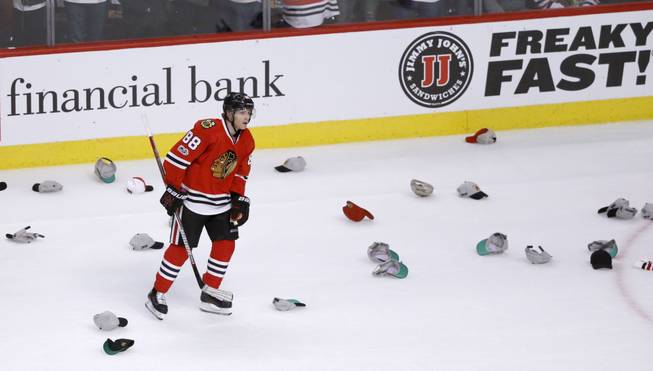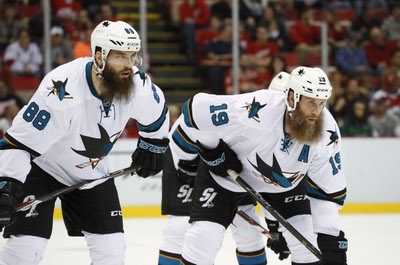
Charles Rex Arbogast / AP FILE
Chicago Blackhawks’ Patrick Kane skates between several hats after scoring a hat trick against the Pittsburgh Penguins, during the third period of an NHL hockey game Wednesday, March 1, 2017, in Chicago. The Blackhawks won 4-1.
Saturday, May 20, 2017 | 2 a.m.
Related content
A forward skates past the defender eyeing another goal. He head fakes the goalie and calmly slides the puck into the net for his third goal of the game.
Before the goal horn finishes sounding he and his teammates are bombarded with hats flying onto the ice.
The National Hockey League fans came prepared, knowing exactly when to chuck their cap onto the arena ice with no prompt needed. The arena’s staff was equally prepared, opening the boards and sending dozens of workers armed with snow shovels onto the rink to scoop up the hats.
What happens after? Most teams give fans a week or two to reclaim their hats. The unclaimed hats are usually donated to local charities. Some teams like the Penguins, Blue Jackets and Flyers have display cases in the arena where the hats are kept, and some players keep a hat or two as a memento.
The NHL is dripping with long-standing traditions and superstitions. Some are league-wide while some belong to a particular fan base.
“One thing I think hockey players have done really well is passing those down from generation to generation,” Golden Knights Senior Vice President Murray Craven said.
Here are some of the best traditions surrounding the NHL:
Hats aren’t the only things thrown over the boards
Players aren’t greeted with flying headgear in Detroit following a third goal. Instead, eight slimy tentacles of cold, smelly flesh come crashing onto the ice at Joe Louis Arena. The “Legend of the Octopus” started on April 15, 1952, when Pete and Jerry Cusimano, brothers and storeowners in Detroit, threw an octopus onto the ice. The creature’s eight arms were meant to signify the eight wins needed to claim a Stanley Cup (back when the playoffs only consisted of two rounds).
Ever since, Red Wings fans have continued the tradition, including a game in 1995 when more than 30 octopuses were tossed onto the ice. Even the team’s mascot is an octopus named Al.
“We weren’t very good when I was in Detroit so there was no reason for them to throw the octopuses,” said Craven, who was a Red Wing from 1982-84. “After I had been traded they found some success in the late 80s and the octopuses came back and made an appearance again.”
Al Sobotka, the Joe Louis Arena ice manager, swings the octopuses above his head as he exits the rink.
“That’s a different one for sure,” Craven said. “That’s unlike anywhere else.”
Other teams have tried to replicate the tradition and make it their own. Florida Panthers’ fans began throwing plastic rats on the ice following goals after Scott Mellanby killed a rat in the locker room with his stick and proceeded to score two goals in the game. The NHL created a rule to allow referee’s to penalize the crowd after fans would celebrate the “Rat Trick” after every single goal during the Panthers’ 1996 playoff run.
San Jose fans threw a 3-foot leopard shark onto the ice in 2007, Oilers fans have thrown steaks onto the ice in Edmonton and Predators’ fans have thrown catfish over the boards in Nashville.
Playoff beards
Nothing says playoff hockey like a long, flowing locks of whiskers protruding around each player’s helmet chinstrap.
The tradition is such that every player must stop shaving when they enter the playoffs, and leave their facial hair untouched until they are either eliminated or win the Stanley Cup. Many fans also don’t shave.
It began with the New York Islanders in the 1980s and has now been adopted by all of the NHL, and even other sports like baseball and football.
“I wasn’t a big beard guy because I always found it itchy,” Craven said. “My first year (in Philadelphia) we went to the finals and I grew one but it wasn’t much of a beard. It was a Texas beard with a lot of wide-open spaces.”
Handshake line
When the final buzzer sounds at the end of a hard-fought best of seven series in the Stanley Cup Playoffs the players line up at center-ice.
No matter how bloodied, bruised and battered their bodies (and egos) are, the players always form lines to shake hands.
“It’s a time-honored tradition and I think it shows sportsmanship,” Craven said. “It transcends other sports just the way it looks with everyone lining up on the ice.”
In 2014 Canadiens’ forward Brandon Prust broke Derek Stephan’s jaw during the series — then a week later shook each other’s hands in line.
“Sometimes it’s closure,” Craven said. “You can get some real animosity with guys from the other team but it seems when you go through that hand-shake line it can heal some wounds.”


Join the Discussion:
Check this out for a full explanation of our conversion to the LiveFyre commenting system and instructions on how to sign up for an account.
Full comments policy